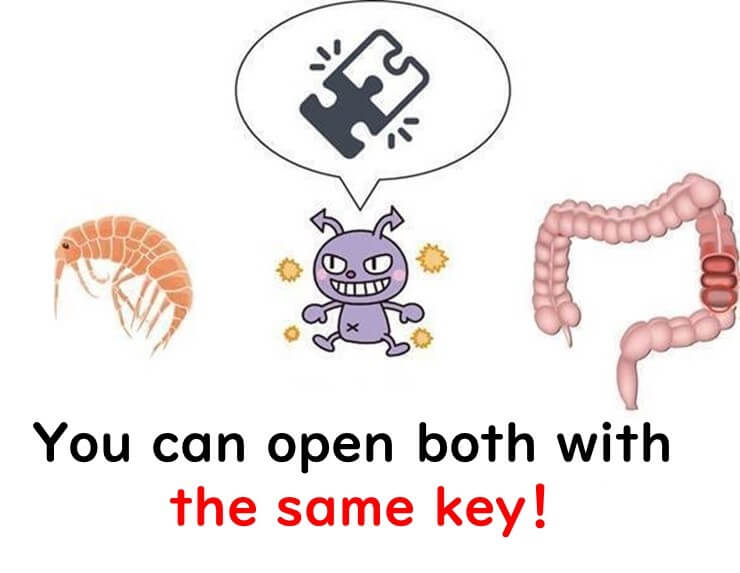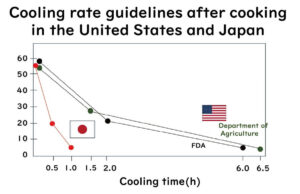Vibrio cholerae can attach to the surfaces of zooplankton such as larval shellfish and shrimp. These environments offer two main benefits to Vibrio cholerae: an abundance of nutrients and protection from various environmental stresses. In this article, we introduce a study suggesting that the genes responsible for cholera toxin, which typically causes human infection, might have originally evolved to help the bacteria survive in natural ecosystems.
Kirn et al.
A colonization factor links Vibrio cholerae environmental survival and human infection
Nature. 2005 Dec 8;438(7069):863-6.
Understanding the Dual Role of Cholera Toxin Genes
When humans ingest Vibrio cholerae, it can lead to the diarrhoeal disease cholera, primarily due to the effects of cholera toxin on intestinal epithelial cells. For the toxin to be produced in sufficient quantities to cause clinical symptoms, the bacteria must first colonise the small intestine.
Dr. Kirn and colleagues at Dartmouth Medical School hypothesised that the factors allowing Vibrio cholerae to adhere to human intestinal epithelial cells might also enable them to adhere to the surfaces of zooplankton. Their experiments successfully identified a protein produced by Vibrio cholerae that binds efficiently to sugars found in both human small intestine epithelial cells and the surfaces of zooplankton.

Identifying the Key Protein
Dr. Kirn's team aimed to identify the proteins involved in Vibrio cholerae colonisation of the intestine by creating a mutant strain of Vibrio cholerae that lacked the adhesion factor for intestinal epithelial cells. Genetic analysis of this adhesion-deficient strain revealed that the gene predicted to encode chitinase was disrupted by a transposon insertion.
Vibrio cholerae can grow in the presence of chitin as their sole carbon source, and several proteins with chitinase and chitin-binding activity have been reported. Previous studies had identified a chitin-binding protein with a molecular weight of 53 kDa. The protein identified by Dr. Kirn's team, named pGbpA, which serves as an adhesion factor for intestinal epithelial cells, also had a molecular weight of 53 kDa, leading them to conclude that both were the same protein.
Testing the Protein's Role in Zooplankton Adhesion
Next, the team investigated whether the pGbpA protein, which facilitates adhesion to human intestinal epithelial cells, also played a role in the bacteria's attachment to zooplankton. They cultured the mutant cholera strain, which lacked the adhesion capability to human cells, with zooplankton and used fluorescence microscopy to count the bacteria adhering to the zooplankton.
The results showed that the mutant strain exhibited about a tenfold reduction in adhesion to the zooplankton's exoskeleton compared to the wild-type strain, demonstrating the protein's crucial role in both human and zooplankton adhesion.
The experimental results confirmed that the role of GbpA in Vibrio cholerae attachment to zooplankton in aquatic ecosystems is the same as its role in colonising human intestinal epithelial cells. Dr. Kirn and his team proposed that other "virulence factors," studied primarily for their role in human disease, might originally serve important functions in aquatic ecosystems.
My Take on This Study

What struck me most in this study is how it invites us to rethink the origin and purpose of microbial "virulence" factors. From my perspective, the key insight is that proteins like pGbpA—long studied for their role in human infection—may have originally evolved to help bacteria survive in aquatic environments, by attaching to chitinous surfaces such as those found on zooplankton.
This challenges a common human-centred view: that microbial traits exist primarily to infect us. But microbes have inhabited Earth for billions of years—long before humans appeared. Traits we interpret as pathogenic may simply be adaptations for life in complex ecosystems, with human infection being a coincidental outcome.
For those of us working in microbiology, this study is a reminder of how much we still have to learn about the ecological roles of so-called virulence genes. Understanding these origins doesn’t necessarily change day-to-day practices in food safety, but it deepens our appreciation of microbial evolution and encourages a broader, more nuanced perspective.
Further Reading
For a broader perspective on the timeline of microbial evolution compared to human history, see:
📄Microorganisms and Humanity: A Brief Encounter in Earth's 4-Billion-Year History
For related studies on the evolutionary origin of pathogenic genes in Vibrio species and the role of deep-sea hydrothermal vents, see:
📄Did Human Pathogenic Genes of Vibrio Species Evolve in Deep-Sea Vents?
